The Many Variants of Metal Roof and Siding Sealants

By AEP Span.
Check out this comprehensive breakdown of types of metal roofs and siding sealants from AEP Span.
When it comes to metal roofing and siding applications, selecting the right sealant is crucial to ensure long-lasting durability and weather resistance. In this article, AEP Span's Technical Services Manager, Jeff Haddock, provides an insightful breakdown of different types of sealants and their recommended uses.
Non-skinning/non-curing butyl sealants
These types of sealants are used purposely in metal roofing and siding applications because panel joints and laps create a very thin space between the materials that are subject to continual dynamic movements which will subject the sealant to shear force. Only a non-skinning, non-curing sealant can perform under such extreme conditions as these types of sealants will never cure or harden over the life of the roof or siding. Butyl sealants should only be used where dynamic movement of the material will take place due to thermal expansion and contraction and are not subjected to exposure to Ultraviolet light. UV light will break down these types of sealants over time making them impractical in exposed applications.
Extruded butyl tape
These types of sealants are used in a similar fashion to non-skinning/non-curing sealants as butyl tape will never cure or harden over its lifetime. Butyl tapes main use is for high infiltration areas such as under the joggle cleat at the eave or valley condition or in areas where a continuous aggressive bead of sealant is recommended such as used to seal the top and bottom of the zee closures on a ridge or peak condition.
Butyl tape is also recommended at the side lap condition of thru-fastened or corrugated profiles due to the fact that gun grade sealants are impractical and messy to apply in a thick continuous bead. Like non-skinning/non-curing sealants, Butyl tape should never be used in applications that are subjected to UV exposure. UV light will break down the sealant over time. Varying sizes of butyl tape are available on the market. Please consult the installation guide or representative for appropriate size recommendations.
Curing sealants
This group of sealants fall into two categories, Urethane and Siliconized. These types of sealants require a specific mass of material, cures relatively hard and can potentially fail when subjected to shear and dynamic forces. AEP Span recommends urethane and siliconized sealant only for non-moving joinery and perimeter seals that are exposed to sunlight and require a curing UV resistant sealant. Siliconized sealants should be used in the same manner as Urethane but are available in a wide array of colors. This is beneficial if white or grey urethane is not desirable for project aesthetics. It should be noted that although these sealants are recommended for use on roof and wall products their use should be limited, as most metal details utilize concealed gun grade non-skinning/non-curing butyl sealants or butyl tape sealants.
As with any sealant, adhesion to a particular surface should be verified with the product manufacturer and or panel manufacturer to ensure the sealant is “fit-for-purpose” for the application and adhesion won’t be impacted.
Original article source: Aep Span
Learn more about AEP Span in their Coffee Shop Directory or visit www.aepspan.com.
About AEP Span
AEP Span is a premier manufacturer of commercial metal roofing and siding products, offering an unrivaled commitment to the success of contractors. AEP Span offers a broad portfolio of extensively tested and accredited products (including Building Code and LEED accreditations).
AEP Span offers extensive support to contractors, including technical and architect support, detailed installation resources, weathertight warranties, and estimation services.























Comments
Leave a Reply
Have an account? Login to leave a comment!
Sign In